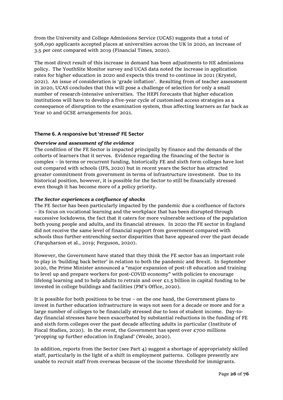
Page 26 of 76
from the University and College Admissions Service (UCAS) suggests that a total of
508,090 applicants accepted places at universities across the UK in 2020, an increase of
3.5 per cent compared with 2019 (Financial Times, 2020).
The most direct result of this increase in demand has been adjustments to HE admissions
policy. The YouthSite Monitor survey and UCAS data noted the increase in application
rates for higher education in 2020 and expects this trend to continue in 2021 (Krystel,
2021). An issue of consideration is 'grade inflation'. Resulting from of teacher assessment
in 2020, UCAS concludes that this will pose a challenge of selection for only a small
number of research-intensive universities. The HEPI forecasts that higher education
institutions will have to develop a five-year cycle of customised access strategies as a
consequence of disruption to the examination system, thus affecting learners as far back as
Year 10 and GCSE arrangements for 2021.
Theme 6. A responsive but 'stressed' FE Sector
Overview and assessment of the evidence
The condition of the FE Sector is impacted principally by finance and the demands of the
cohorts of learners that it serves. Evidence regarding the financing of the Sector is
complex - in terms or recurrent funding, historically FE and sixth form colleges have lost
out compared with schools (IFS, 2020) but in recent years the Sector has attracted
greater commitment from government in terms of infrastructure investment. Due to its
historical position, however, it is possible for the Sector to still be financially stressed
even though it has become more of a policy priority.
The Sector experiences a confluence of shocks
The FE Sector has been particularly impacted by the pandemic due a confluence of factors
- its focus on vocational learning and the workplace that has been disrupted through
successive lockdowns, the fact that it caters for more vulnerable sections of the population
both young people and adults, and its financial stresses. In 2020 the FE sector in England
did not receive the same level of financial support from government compared with
schools thus further entrenching sector disparities that have appeared over the past decade
(Farquharson et al., 2019; Ferguson, 2020).
However, the Government have stated that they think the FE sector has an important role
to play in 'building back better' in relation to both the pandemic and Brexit. In September
2020, the Prime Minister announced a "major expansion of post-18 education and training
to level up and prepare workers for post-COVID economy" with policies to encourage
lifelong learning and to help adults to retrain and over £1.5 billion in capital funding to be
invested in college buildings and facilities (PM's Office, 2020).
It is possible for both positions to be true - on the one hand, the Government plans to
invest in further education infrastructure in ways not seen for a decade or more and for a
large number of colleges to be financially stressed due to loss of student income. Day-today financial
stresses have been exacerbated by substantial reductions in the funding of FE
and sixth form colleges over the past decade affecting adults in particular (Institute of
Fiscal Studies, 2020). In the event, the Government has spent over £700 millions
'propping up further education in England' (Weale, 2020).
In addition, reports from the Sector (see Part 4) suggest a shortage of appropriately skilled
staff, particularly in the light of a shift in employment patterns. Colleges presently are
unable to recruit staff from overseas because of the income threshold for immigrants.